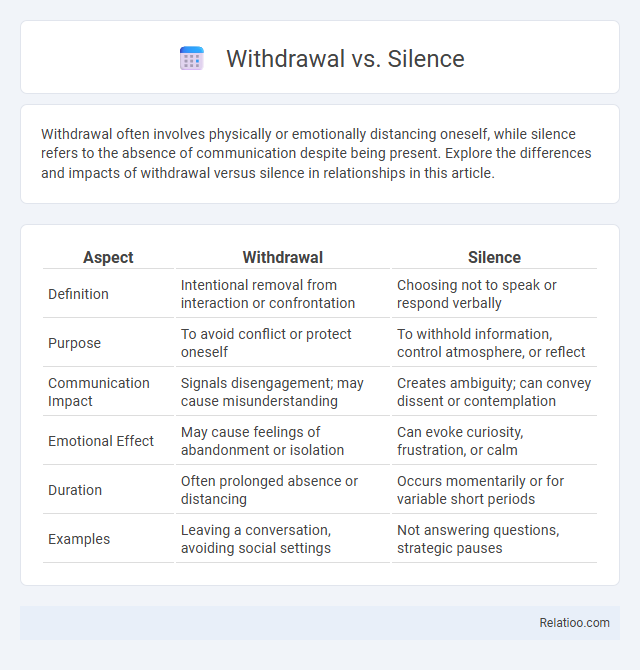Withdrawal often involves physically or emotionally distancing oneself, while silence refers to the absence of communication despite being present. Explore the differences and impacts of withdrawal versus silence in relationships in this article.
Table of Comparison
| Aspect | Withdrawal | Silence |
|---|---|---|
| Definition | Intentional removal from interaction or confrontation | Choosing not to speak or respond verbally |
| Purpose | To avoid conflict or protect oneself | To withhold information, control atmosphere, or reflect |
| Communication Impact | Signals disengagement; may cause misunderstanding | Creates ambiguity; can convey dissent or contemplation |
| Emotional Effect | May cause feelings of abandonment or isolation | Can evoke curiosity, frustration, or calm |
| Duration | Often prolonged absence or distancing | Occurs momentarily or for variable short periods |
| Examples | Leaving a conversation, avoiding social settings | Not answering questions, strategic pauses |
Understanding Withdrawal and Silence
Withdrawal involves actively retreating from social interaction or communication due to emotional distress, while silence is characterized by the absence of verbal expression without necessarily indicating disengagement. Understanding withdrawal requires recognizing it as a coping mechanism that signals a need for personal space or protection from perceived harm. Silence, in contrast, may represent contemplation, agreement, disagreement, or emotional regulation, making its interpretation highly context-dependent in interpersonal dynamics.
Key Differences Between Withdrawal and Silence
Withdrawal involves physically or emotionally distancing oneself from social interactions, often signaling avoidance or discomfort, while silence refers to the absence of verbal communication without necessarily implying disengagement. Withdrawal typically manifests as reduced participation or complete isolation, whereas silence can serve as a deliberate, communicative pause or strategy within ongoing interactions. Understanding these distinctions clarifies behavioral intentions and informs appropriate responses in social and psychological contexts.
Psychological Reasons Behind Withdrawing
Withdrawal, silence, and retreat stem from psychological defense mechanisms individuals use to manage stress, anxiety, or emotional pain. Withdrawal often indicates a need for self-preservation and emotional regulation, as people distance themselves to avoid further psychological harm. Silence, in this context, may serve as a protective barrier, allowing space for internal reflection and processing before re-engaging with external stimuli.
Why People Choose Silence
People choose silence as a response to conflict because it allows them to avoid escalation and maintain personal boundaries without direct confrontation. Silence serves as a protective mechanism to process emotions internally and prevent misunderstandings that might arise from immediate verbal reactions. Unlike withdrawal, which physically or emotionally distances a person, silence provides a subtle way to express discontent while preserving the relationship's external stability.
Emotional Impact of Withdrawal vs Silence
Withdrawal often leads to feelings of abandonment and confusion, intensifying emotional distress more than silence, which can be interpreted as mere indifference or non-communication. The emotional impact of withdrawal is typically stronger because it involves an active retreat from interaction, fostering insecurity and loneliness. In contrast, silence may create space for reflection but can also generate anxiety depending on context and relationship dynamics.
Signs and Symptoms of Withdrawal
Withdrawal symptoms vary depending on the substance but commonly include anxiety, sweating, nausea, and irritability. Silence during withdrawal may signal emotional distress or difficulty coping with these symptoms, often manifesting as social withdrawal or lack of communication. Recognizing these signs early helps you provide timely support and seek appropriate medical intervention.
When Silence Becomes a Communication Tool
Silence becomes a powerful communication tool when it conveys unspoken emotions or messages that words cannot capture, often signaling discomfort, disagreement, or contemplation within interpersonal exchanges. Withdrawal differs by involving physical or emotional retreat, reducing interaction to avoid conflict or emotional pain. Understanding the nuanced use of silence helps decode implicit messages in relationships, distinguishing it from withdrawal behaviors that imply disengagement rather than intentional communication.
Coping Strategies for Withdrawal
Withdrawal involves actively removing yourself from social or emotional interactions, while silence often denotes a passive lack of communication. Coping strategies for withdrawal include setting clear personal boundaries, engaging in mindfulness practices to reduce stress, and seeking supportive relationships that encourage open dialogue. Understanding your reasons for withdrawal can help tailor effective techniques to manage emotional well-being.
Healthy Ways to Navigate Silence
Navigating silence in relationships requires recognizing the differences between healthy withdrawal and destructive silence, which can create emotional distance and misunderstanding. You can practice open communication, setting boundaries, and reflecting on your emotions to transform withdrawal into a constructive pause rather than an isolating silence. Prioritizing empathy and honest dialogue fosters connection and promotes mutual understanding, helping relationships thrive despite moments of quiet.
Seeking Help: When to Address Withdrawal or Silence
Withdrawal and silence often signal emotional distress, making timely intervention crucial for effective support. Recognizing signs such as prolonged social isolation or uncommunicative behavior helps differentiate between voluntary silence and harmful withdrawal, guiding appropriate help-seeking strategies. Addressing these behaviors promptly fosters mental health recovery by encouraging open communication and professional assistance.

Infographic: Withdrawal vs Silence
 relatioo.com
relatioo.com